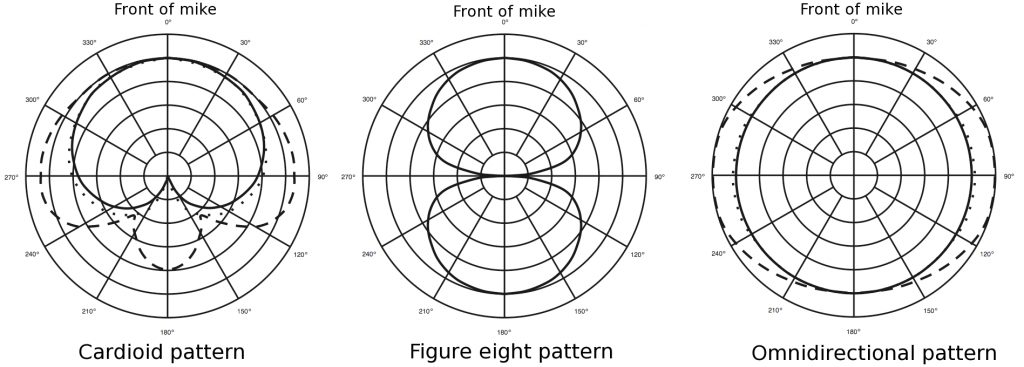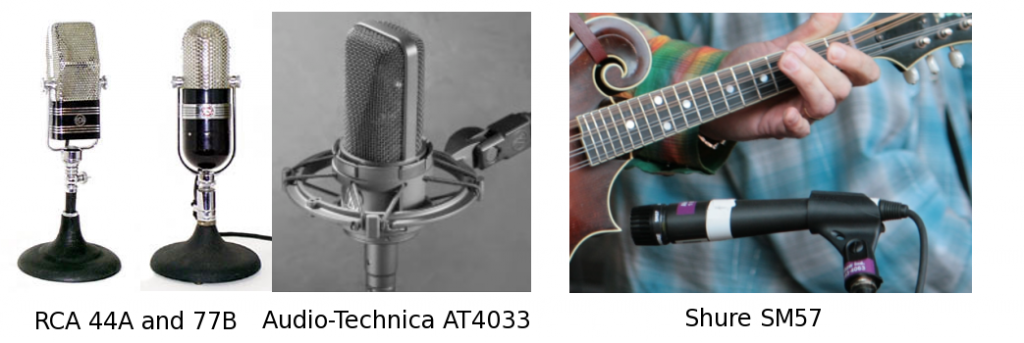The Traditional Bluegrass Microphone Technique: Part 1
This article of mine appeared in the Northern Bluegrass Circle Music Society's September newsletter. Part 2 will appear in January.
----
As most bluegrass aficionados are aware, many bluegrass and olde tyme musicians prefer the single mike technique for sound reinforcement. This technique can work quite well, but musicians need to understand how to work the mike properly in order to achieve the best sound. With one mike, and therefore one channel in operation at the mixing board, the sound person can do little to modify the sound - it's up to the musicians to achieve a good blend of instruments and voices. This can be difficult since the musicians can't hear exactly what the audience is hearing. The main performing advantages of the single mike technique are: the players get close together so they can hear and blend voices and instruments well, and it looks really cool as the musicians whiz around taking turns singing and playing instrumental breaks. This two-part article is intended to help people understand a little more about this technique. Part 1 talks briefly about the history and some technical details about microphones, and Part 2 will discuss proper microphone technique.
Part 1: History and Technical Stuff
Legend has it that way back before most of us were born, there weren't no iPods and there weren't no 'lektricity. Most music venues were designed with good acoustics, performances were small, and musicians knew how to project their sound acoustically. The arrival of newfangled technology: radio broadcast and sound reinforcement in the 1920s, allowed performers to be heard by much larger audiences. The earliest sound systems were simple, using a single omnidirectional or figure eight microphone with one amplifier channel to pick up an entire band. Musicians adapted, moving around the mike as necessary. As it turns out, much of country and bluegrass music was developing at this particular time. Although multiple channels are now easily and cheaply available, traditionalists prefer to use a single mike.
The Microphone
The term "omni" microphone is often misused. Omnidirectional microphones pick up sound equally all around the mike, but this is not very good since the band usually clusters on one side of the mike facing the audience. Omni mikes would pick up the audience side also, and suffer very badly from feedback problems. Therefore, most mikes used in live situations today are directional, having a "cardioid" pickup pattern. They generally pick up sound within about a 120 degree range on one side of the mike, and reject sound on the other side. Some mikes can be switched between cardioid, figure eight, and omni pickup patterns. Fig. 1 shows cardioid, figure eight and omni polar patterns. The polar pattern shows the level of pickup as you move around the mike. For example, the cardioid polar plot shows higher pickup at the front of the mike, lower pickup off to the sides, and almost no pickup at the back of the mike.

Figure 1: Cardioid, figure eight, and omnidirectional mike patterns. The solid line indicates the pickup “zone.”
Popular mikes in the bluegrass world are the Audio-Technica AT4033 and the Shure KSM32/44. These are high-quality, high-sensitivity, large-diaphragm condenser mikes. They have very clear sound, but they do not have quite the same sound of the RCA 44A and 77B ribbon mikes that were often used at the Grand Ole Opry, WSM radio, and in early recordings. Fig. 2 shows the old-timer ribbon mikes, the modern AT4033 condenser mike, and the Shure SM57, a very common dynamic mike.

Figure 2: RCA 44A and 77B (ribbon mikes), the modern AT4033 (condenser) with shockmount, and the Shure SM57 (dynamic)
Dynamic, condenser, or ribbon mike? There's too much techie stuff required to explain the differences fully, but here is a summary. Dynamic mikes are very cheap, and immune to abuse (dropping them, swinging them through the air) and thus have become very popular live mikes. Condenser and ribbon mikes are generally more expensive (although that has changed a lot recently), have much better sound, and are susceptible to damage. Also, condensers require "phantom power" (48 volt power sent from the mixing board) while dynamics and ribbons do not. Ribbons are the most expensive and the most delicate, so usually large-diaphragm cardioid (directional) condenser mikes are favoured for live sound. The condenser diaphragm is the part that converts the sound to an electrical signal. A large diaphragm gives better low end response, but sometimes this is at the expense of high frequency detail.
Microphone Characteristics
You probably already know that the closer you get to a mike, the louder it picks up. So you need to be fairly close to be heard. What you may not realize, is that proximity to the mike also affects the tone of the sound. Generally, the best sound is directly in front of the mike and about six to eighteen inches away from the mike. When you get too close, the mike starts to sound really boomy (this is called the proximity effect, and the amount varies from one microphone to another), and it can pick up "plosives" like "p," "b," etc., and that can sound really bad amplified. You may also get distortion due to the high sensitivity, or you can suddenly get too loud and wake up the sound guy (and that's never a good thing). If you're too far from the mike, the sound gets really thin and tinny sounding, and the mike picks up more echoey room sound relative to the direct sound. Moving from the centre of the mike off to the side also changes the tonal quality somewhat. Mikes pick up footstomps on the stage, wind blowing through the mike's grill, and the entire acoustic space the band is in (not to mention DTTW's bottles tinkling, and any mumbling band members). Mikes should be mounted in a shock mount (that cage thing), and at outdoor festivals it's a good idea to use a windscreen. The quality of the acoustic surroundings is an often overlooked part of the sound. If the stage area is boxy and echoey sounding, that's what will get into the mike and amplified, and there will be big problems with feedback. The single mike technique is especially difficult to use in a bad acoustic space.
That's about enough for this instalment. Please tune in next time when I discuss microphone technique.
by Kevin Jacobson (www.cavemusic.ca)